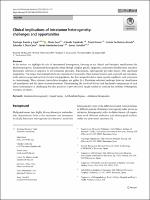Clinical implications of intratumor heterogeneity: challenges and opportunities

Author
Date
2020-02Permanent link
https://hdl.handle.net/11351/6436DOI
10.1007/s00109-020-01874-2
ISSN
1432-1440
WOS
000508697200001
PMID
31970428
Abstract
In this review, we highlight the role of intratumoral heterogeneity, focusing on the clinical and biological ramifications this phenomenon poses. Intratumoral heterogeneity arises through complex genetic, epigenetic, and protein modifications that drive phenotypic selection in response to environmental pressures. Functionally, heterogeneity provides tumors with significant adaptability. This ranges from mutual beneficial cooperation between cells, which nurture features such as growth and metastasis, to the narrow escape and survival of clonal cell populations that have adapted to thrive under specific conditions such as hypoxia or chemotherapy. These dynamic intercellular interplays are guided by a Darwinian selection landscape between clonal tumor cell populations and the tumor microenvironment. Understanding the involved drivers and functional consequences of such tumor heterogeneity is challenging but also promises to provide novel insight needed to confront the problem of therapeutic resistance in tumors.
Keywords
Intratumor heterogeneity; Artificial intelligence; Antitumor therapeuticsBibliographic citation
Ramón y Cajal S, Sesé M, Capdevila C, Aasen T, De Mattos-Arruda L, Diaz-Cano SJ, et al. Clinical implications of intratumor heterogeneity: challenges and opportunities. J Mol Med (Berl). 2020 Feb;98(2):161–177.
Audience
Professionals
This item appears in following collections
- HVH - Articles científics [4471]
- VHIO - Articles científics [1250]
- VHIR - Articles científics [1751]
The following license files are associated with this item:

 Private area
Private area Contact Us
Contact Us







